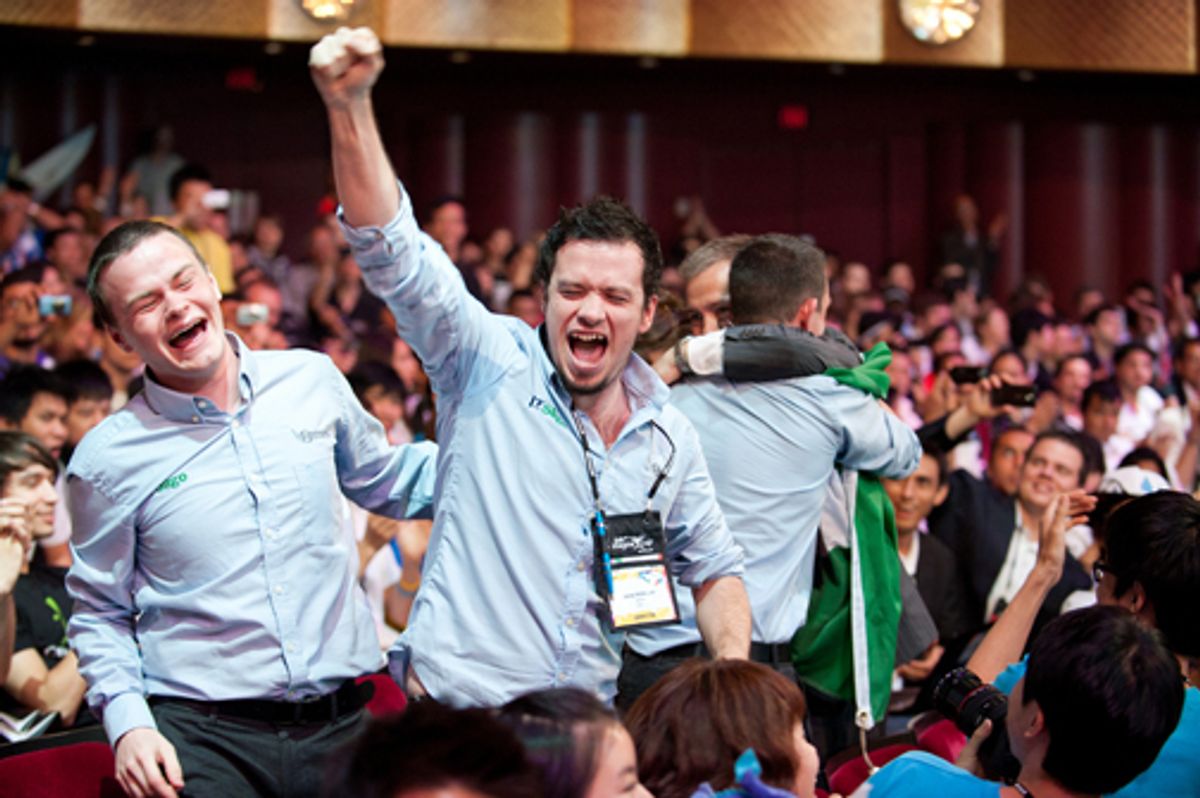[ PHOTO: Team Hermes from Ireland wins the software design competition in this years' Imagine Cup worldwide finals. Credit: Microsoft]
"James, what are we going to do with the money?" I heard Aine Conaghan ask on the other end of the telephone line.
This month, she and her teammates Matthew Padden, Calum Cawley and James McNamara from the Sligo Institute of Technology in Ireland took first place in the Software Design category at Mircosoft's Imagine Cup worldwide finals—an annual student technology competition that attracts participants from all around the globe. Of the nine categories in the competition, Software Design is the largest and most prestigious, which makes the Irish students this year's Imagine Cup all-stars. At the awards ceremony in New York City's Koch Theater, the team was presented with the silver "Imagine Cup" trophy and a poster-sized check for US$25,000.
"James says he's going to use his money to make a payment on a Harley," Conaghan laughed into the receiver. It was Saturday morning, a week and a half after the competition. The day before, the four teammates presented their winning project at Microsoft's Global Exchange (MGX) conference in Denver, Colorado to about 14,000 Microsoft employees. They got three standing ovations. On Saturday, they had a small window of downtime at their hotel before catching a plane back to Ireland, where they'd been booked for a Monday morning interview at a local TV station.
They call their team and their project Hermes, after the Greek god who protects travelers. They believe their technology will help reduce road traffic accidents, which Conaghan says is a "serious huge problem" that costs the world about $420 billion a year and is the leading cause of death among people ages 10 to 24.
Project Hermes consists of a charger-like device that plugs into the diagnostics port of any car made since 2000. It tracks the driver's behavior by monitoring things like speed, GPS location, RPM and acceleration, then uploads that information to the cloud. A cloud application analyzes the data and sends near-instant reports to the driver's phone, advising him to change his behavior or warning him of a bad road ahead. The system can also be set up to send data to the car's owner—for example, an anxious parent or the manager of a delivery fleet.
Conaghan and her teammates joke about using their prize money for "holidays" and for paying off student loans, she said, but they've also talked seriously about starting their own company. They've even been in touch with a couple American insurance companies intrigued with the idea of using Hermes data to offer safe drivers lower premiums. Of course, the team still needs to do clinical trials and more field tests before they can put Hermes on the market. And they need to find "a smart VC who would want to roll on with the company," Conaghan adds. But they all agree that without the publicity they gained from the Imagine Cup, the support from Microsoft, and the connections they made at the competition, they would never have dreamed they could push their ideas as far as they already have.
It's a common sentiment among competitors heading home after the Imagine Cup. And it's not just the winners who feel this way.
"Imagine Cup opened our minds and helped us realize the potential of our project," said Zbynek Poulicek, whose team from the Czech Republic competed in last years' worldwide finals in Warsaw, Poland. Although the team didn't place in the final round, the competition inspired them to form a company around their technology. They now head up GINA Systems, which has deployed its Geographical Information Assistant (GINA) software in disaster zones around the world. The European Union, for example, uses GINA as part of its ECHO Project to monitor the spread of cholera in Haiti. The software lets first responders use their PDAs to do things like send messages over poor data networks and use touch technology to mark emergency locations on interactive maps.
Suzi LeVine, who is the Director of Microsoft Academic Programs, said the quality of student projects entering the Imagine Cup worldwide finals gets more impressive every year. Part of the reason for this, of course, is that as the event gets more popular, the competition gets steeper. But LeVine also pointed out that the tools students use to build their projects are also improving. After Microsoft released Azure in 2008, for example, "all of a sudden we had many projects that utilized cloud services to make their solutions even more powerful." This year, LeVine said, many students were also inspired to use Azure combined with Windows Phone 7 "to turn smartphones into smart and extra powerful phones."
Students entering projects in the Imagine Cup aren't required to use all Microsoft technologies, LeVine said, though all Software Design teams are required to use the .NET framework. But most teams use primarily Microsoft technologies anyway.
"From the ground up it's been all Microsoft," McNamara said, speaking of Hermes. He likes that the Microsoft products—Silverlight, Azure, Phone 7, Touch, and others—"all tie together seamlessly." However, there is one problem. "The phone apps won't have the market share that we need," he said. If Team Hermes decides to develop their software into a sellable product, "we would also want to develop Android and iPhone apps to make it available to everyone."
Check out some of the teams who placed in Embedded Development, Game Design, and other categories here.



